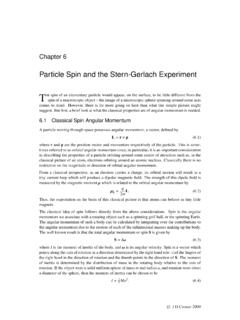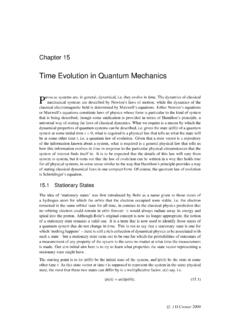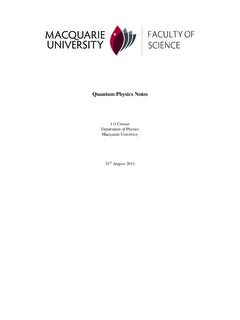Transcription of Observables and Measurements in Quantum Mechanics
1 Chapter 13 Observables and Measurements in QuantumMechanicsTillnow, almost all attention has been focussed on discussing thestateof a Quantum we have seen, this is most succinctly done by treating the package of information thatdefines a state as if it were a vector in an abstract Hilbert space. Doing so provides the mathemat-ical machinery that is needed to capture the physically observed properties of Quantum method by which the state space of a physical system can be set up was described in wherein an essential step was to associate a set of basis states of the system with the ex-haustive collection of results obtained when measuring some physical property, or observable, ofthe system.
2 This linking of particular states with particular measured results provides a way thatthe observable properties of a Quantum system can be described in Quantum Mechanics , that is interms of Hermitean operators. It is the way in which this is done that is the main subject of in Quantum MechanicsQuantumSystemSMeasuringApparatu sMSurrounding EnvironmentEFigure :SystemSinteracting withmeasuring apparatusMin the presence ofthe surrounding environmentE. The out-come of the measurement is registered onthe dial on the measuring of the most difficult and controversial problemsin Quantum Mechanics is the so-called measurementproblem.
3 Opinions on the significance of this prob-lem vary widely. At one extreme the attitude is thatthere is in fact no problem at all, while at the otherextreme the view is that the measurement problemis one of the great unsolved puzzles of Quantum me-chanics. The issue is that Quantum Mechanics onlyprovides probabilities for the different possible out-comes in an experiment it provides no mechanismby which the actual, finally observed result, comesabout. Of course, probabilistic outcomes feature inmany areas of classical physics as well, but in thatcase, probability enters the picture simply becausethere is insufficient information to make a definiteprediction.
4 In principle, that missing information isthere to be found, it is just that accessing it may be a practical impossibility. In contrast, there isno missing information for a Quantum system, what we see is all that we can get, even in prin-ciple, though there are theories that say that this missing information resides in so-called hiddenvariables . But in spite of these concerns about the measurement problem, there are some fea-tures of the measurement process that are commonly accepted as being essential parts of the finalstory. What is clear is that performing a measurement always involves a piece of equipment thatc J D Cresser 2009 Chapter 13 Observables and Measurements in Quantum Mechanics163is macroscopic in size, and behaves according to the laws of classical physics.
5 In Section , theprocess of decoherence was mentioned as playing a crucial role in giving rise to the observed clas-sical behaviour of macroscopic systems, and so it is not surprising to find that decoherence playsan important role in the formulation of most modern theories of Quantum measurement. Any quan-tum measurement then appears to require three components: the system, typically a microscopicsystem, whose properties are to be measured, the measuring apparatus itself, which interacts withthe system under observation, and the environment surrounding the apparatus whose presence sup-plies the decoherence needed so that, for all practical purposes (FAPP) , the apparatus behaveslike a classical system, whose output can be, for instance, a pointer on the dial on the measuringapparatus coming to rest, pointing at the final result of the measurement, that is, a number on thedial.
6 Of course, the apparatus could produce an electrical signal registered on an oscilloscope, orbit of data stored in a computer memory, or a flash of light seen by the experimenter as an atomstrikes a fluorescent screen, but it is often convenient to use the simple picture of a experimental apparatus would be designed according to what physical property it is of thequantum system that is to be measured. Thus, if the system were a single particle, the apparatuscould be designed to measure its energy, or its position, or its momentum or its spin, or some otherproperty. These measurable properties are known asobservables, a concept that we have alreadyencountered in Section But how do we know what it is that a particular experimental setupwould be measuring?
7 The design would be ultimately based on classical physics principles, ,if the apparatus were intended to measure the energy of a Quantum system, then it would alsomeasure the energy of a classical system if a classical system were substituted for the quantumsystem. In this way, the macroscopic concepts of classical physics can be transferred to quantumsystems. We will not be examining the details of the measurement process in any great depth , we will be more concerned with some of the general characteristics of the outputs of ameasurement procedure and how these general features can be incorporated into the mathematicalformulation of the Quantum and Hermitean OperatorsSo far we have consistently made use of the idea that if we know something definite about thestate of a physical system, say that we know thezcomponent of the spin of a spin half particle isSz=12!
8 , then we assign to the system the state|Sz=12! , or, more simply,|+ . It is at this pointthat we need to look a little more closely at this idea, as it will lead us to associating an operatorwith the physical concept of an observable. Recall that an observable is, roughly speaking, anymeasurable property of a physical system: position, spin, energy, momentum .. Thus, we talkabout the positionxof a particle as an observable for the particle, or thezcomponent of spin,Szas a further observable and so we say that we know the value of some physical observable of a Quantum system, weare presumably implying that some kind of measurement has been made that provided us withthis knowledge.
9 It is furthermore assumed that in the process of acquiring this knowledge, thesystem, after the measurement has been performed, survives the measurement, and moreover ifwe were to immediately remeasure the same quantity, we would get the same result. This iscertainly the situation with the measurement of spin in a Stern- gerlach experiment . If an atomemerges from one such set of apparatus in a beam that indicates thatSz=12!for that atom,and we were to pass the atom through a second apparatus, also with its magnetic field orientedin thezdirection, we would find the atom emerging in theSz=12!
10 Beam once again. Undersuch circumstances, we would be justified in saying that the atom has been prepared in the state|Sz=12! . However, the reality is that few Measurements are of this kind, the system beingsubject to measurement is physically modified, if not destroyed, by the measurement extreme example is a measurement designed to count the number of photons in a single modec J D Cresser 2009 Chapter 13 Observables and Measurements in Quantum Mechanics164cavity field. Photons are typically counted by photodetectors whose mode of operation is to absorba photon and create a pulse of current.










